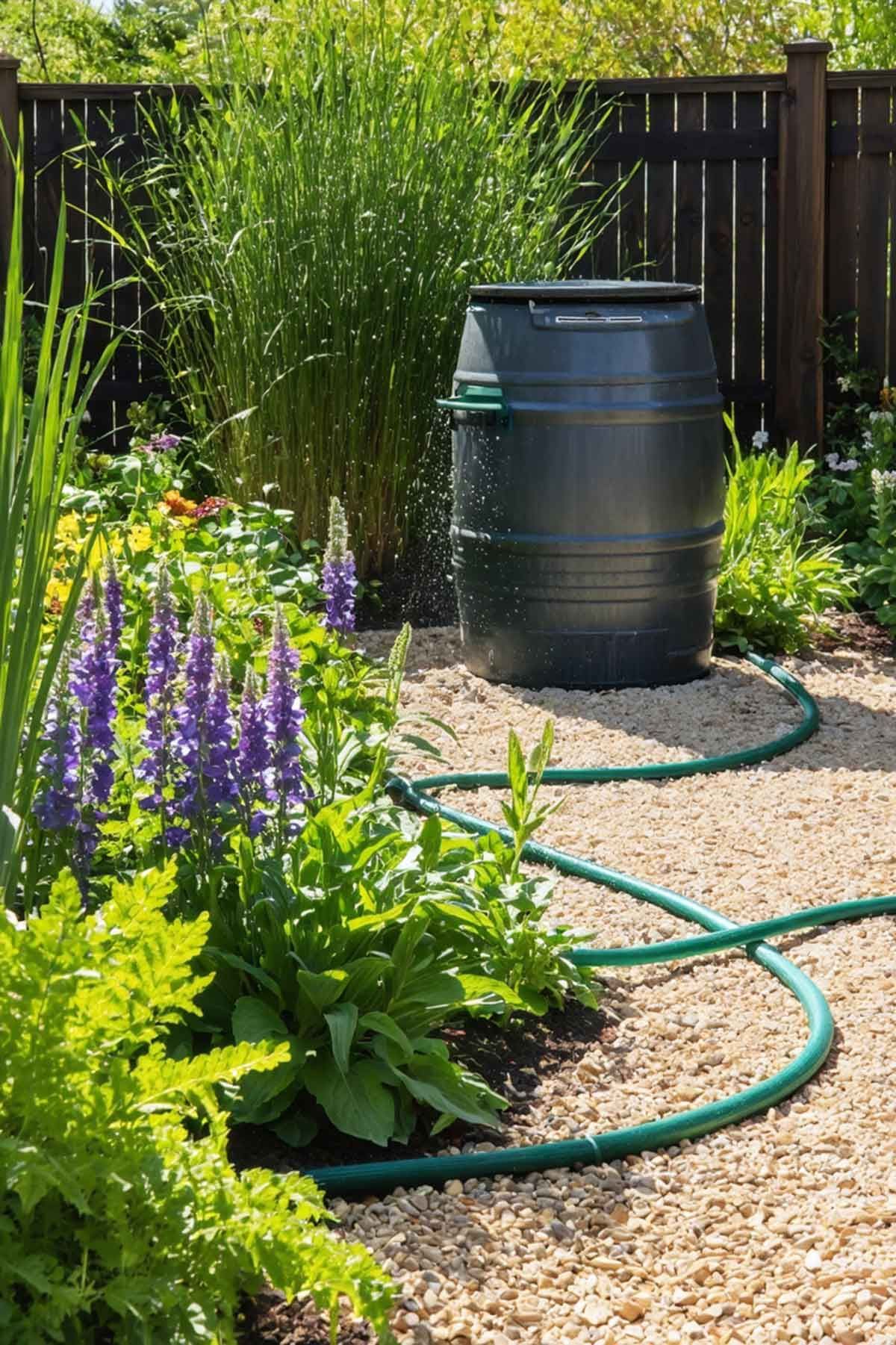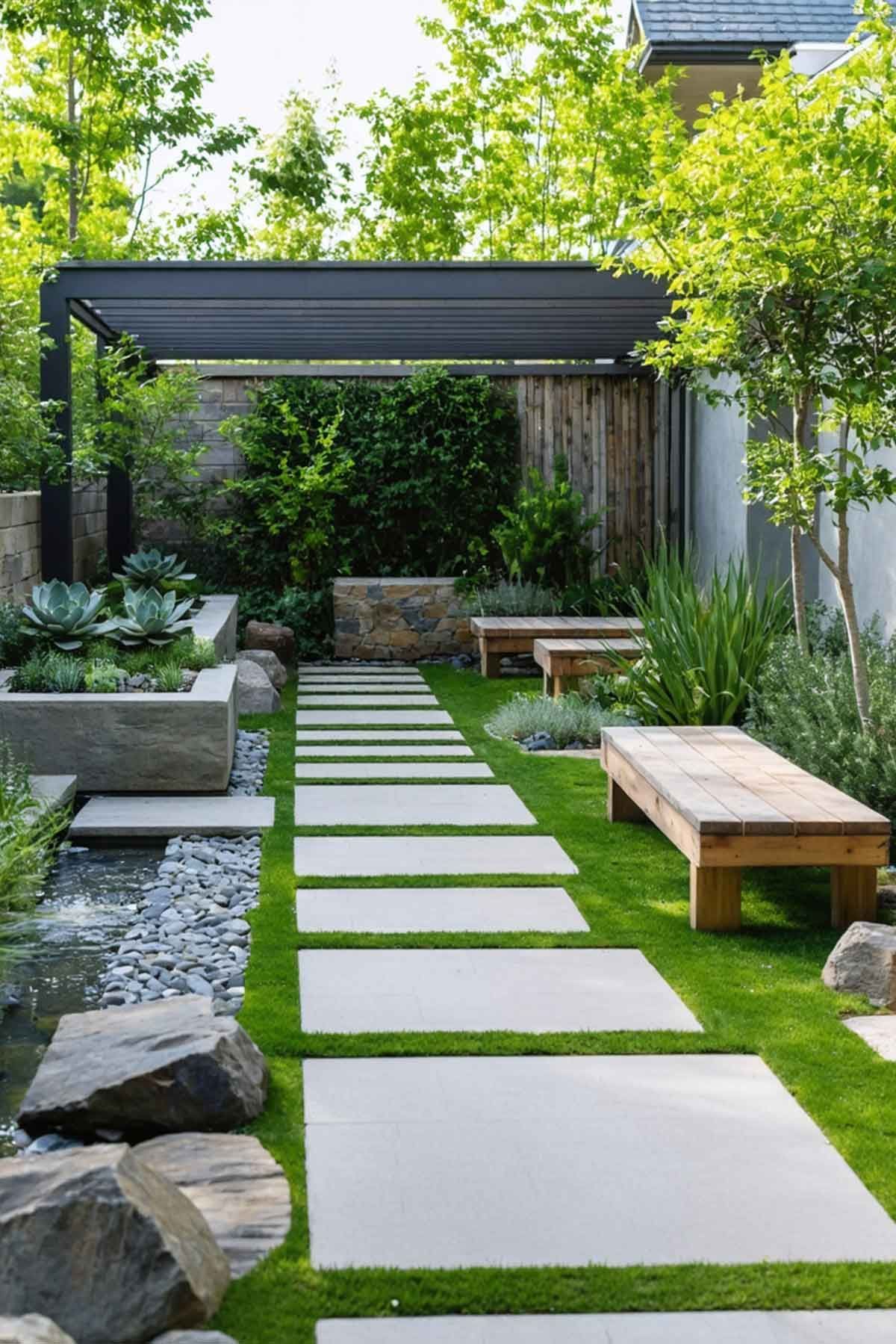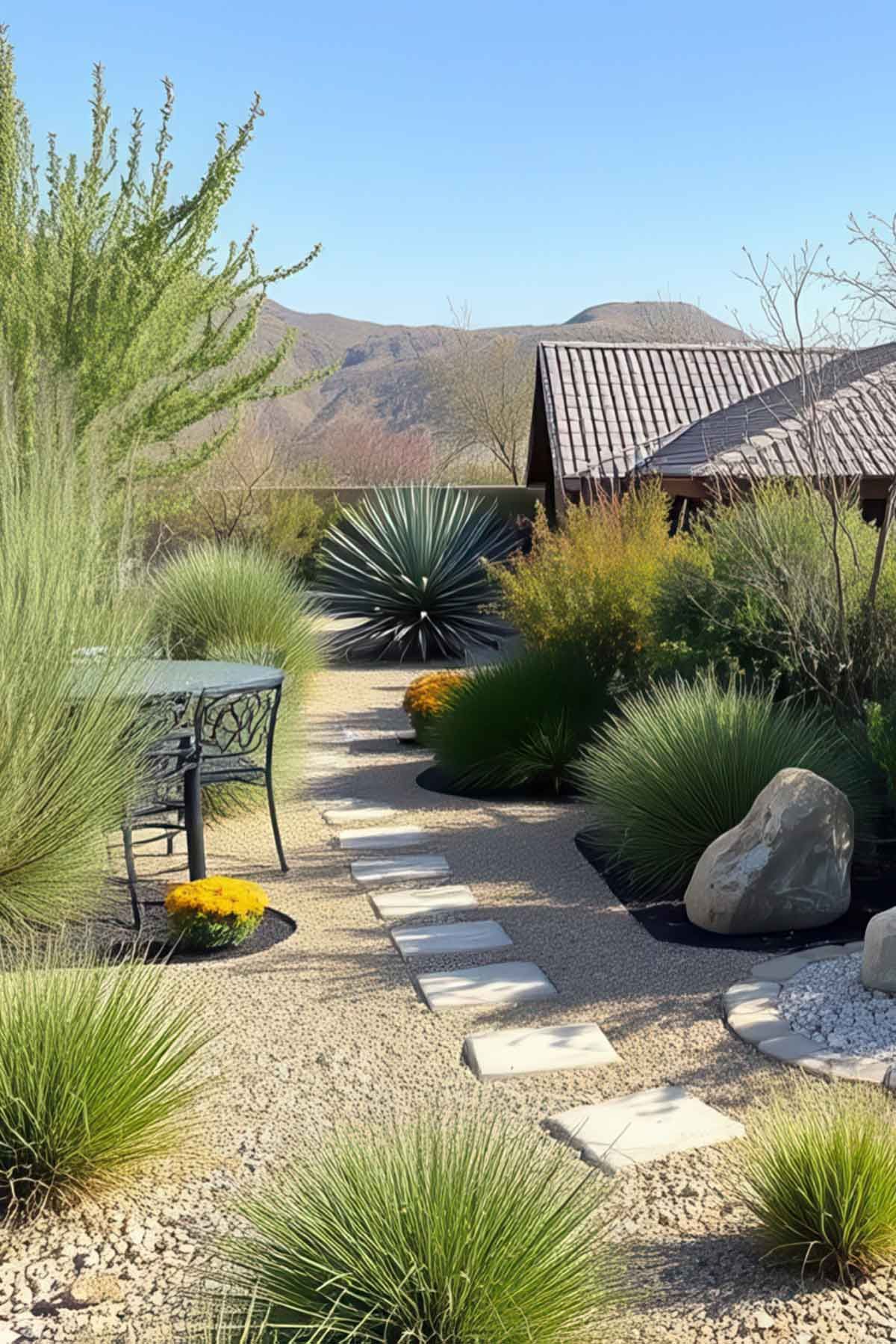How to Create a Low-Maintenance Garden
Creating a Low Maintenance Gardens
Creating a beautiful garden doesn’t have to be hard work. With the right plan, you can have a stunning, easy-to-care-for outdoor space. Focus on the best plants, a smart layout, and simple gardening tips.
Begin with low maintenance garden basics like perennials, ground cover, and evergreen shrubs. These plants need less care and add beauty all year. Also, think about replacing lawns with decking, paving, or gravel. This cuts down on mowing and edging time.
For an easy-care landscaping look, go for simple designs. These styles need less work than old-fashioned gardens. Add features like benches or trellises for lasting beauty with little upkeep.
Choose wisely and design a time-saving garden to enjoy. Start your journey to a low-maintenance paradise today. Turn your garden into a peaceful retreat.
Understanding Low-Maintenance Gardens
Creating a low-work garden is a smart choice for sustainable landscaping . These gardens need little care, using resources wisely and harming the earth less. They save time, water, and are better for the environment.
Definition and Benefits
A low-maintenance garden needs little upkeep to stay healthy and look good. It uses efficient plants, smart layouts, and good soil. This means you get a beautiful outdoor space with much less effort.
Common Misconceptions
- Low-maintenance doesn’t mean no maintenance. Periodic attention is still required to keep things looking their best.
- These gardens are not lacking in aesthetics. With the right design, a low-work garden can be just as visually stunning as a high-maintenance one.
- Sustainability and beauty are not mutually exclusive. A low-maintenance garden can be both ecologically sound and a feast for the senses.
Finding the right balance between form and function is key. Create a space that feeds your soul and the land. With the right knowledge, you can have a thriving, low-work garden that impresses everyone.
“A garden should make you feel you’ve entered privileged space — a place not just set apart but reverberant and charged with meaning, not just a garden but a world.” – Michael Pollan
Selecting the Right Plants
When designing a low-maintenance garden, choose plants that fit your local climate and soil . Native Australian plants , succulents and cacti are perfect for this. They need less water, fertilizer, and pest control than other plants.
Native Plants for Low Upkeep
Think about using native plants like Wattles, Acacia and native grasses. These Australian natives are easy to grow, some provide tasty fruit, and all will give some level of shade, and a home for wildlife.
Just be sure to check their fully grown specifications and remember that gum trees, even if they don’t grow massive will suck the life out of everything around them. They are stunning trees but not a tree you can plant undergrowth with.
Drought-Tolerant Options
In dry areas, pick drought-resistant plants. Succulents are amazing in how fast they grow, but they aren’t as drought tolerant as some people think. I have MANY succulents and while they don’t need to be watered as often as my indoor plants they aren’t set and forget like cacti can be.
You can find lots of agaves, dracaenas and hardy plants at your local nursery. If they are growing in the sun there, they should be fine for your garden.
Perennials vs. Annuals
Perennials are better for low-maintenance gardens. They come back year after year, unlike annuals. Plants like Limonium perezii blue and Native Violet are great examples.
For something dramatic, try Birthday Candles a wattle. It’s a perennial that needs little care.
By choosing native, drought-resistant, and perennial plants, you can have a beautiful garden with little effort. Enjoy the natural beauty of these plants and have a sustainable outdoor space.

Designing an Efficient Layout
Starting a low-maintenance garden means planning well. Organize your outdoor space to save time and enjoy it more. We’ll look at garden zoning and sunlight to make your garden easy to care for.
Zones and Pathways
Split your garden into zones for different uses, like relaxing, dining, and playing. This makes your garden neat and easy to care for. Use wide, crushed-gravel paths (1.5m+ for main paths, 1.2m+ for secondary) for easy access. This cuts down on the need for constant edging or mowing.
Put seating areas along these paths. This way, you can stop and enjoy your garden more often. Obviously place the seating where it will be best in the season you want to use it in. We have multiple options in our small garden depending on the season and time of day and it works really well.
Maximizing Sunlight Exposure
Choosing the right spot for plants is key. Put sun-loving plants in sunny spots and shade-tolerant ones in the shade. Remove narrow grass strips and merge them into bigger, easier-to-care-for beds.
“By creating distinct zones and maximizing sunlight exposure, you can design a low-maintenance garden that is both beautiful and practical.”
For a great garden layout, balance looks and function. With some planning and creativity, your garden will be a beautiful, easy spot to relax. You’ll spend less time on upkeep and more time enjoying it.
Soil Preparation and Maintenance
Starting a garden means building a strong base – the soil. Good soil supports healthy plants. With a few simple steps, you can make your garden thrive with little work.
Importance of Quality Soil
Healthy soil is essential for a great garden. By improving your soil, you’ll need to water, feed, and weed less. Adding compost makes the soil rich and keeps it moist, stopping weeds. Be very careful here. We got some bags of potting mix from a large Australian supplier (I will leave that to your imagination) about 2 years ago and every single pot on my deck has that awful clover. I just can’t get rid of it. So be sure that its quality soil with no weeds or other nasties.
Mulching for Moisture Retention
Organic mulching is key to keeping your garden healthy. A 10-15cm layer of compost or compost tea each year keeps the soil moist. It also keeps the temperature right and stops weeds from growing. This method means you won’t have to water, feed, or weed as often.
- Improve soil structure and fertility through compost addition
- Apply a 10-15cm layer of organic mulch annually to retain moisture and suppress weeds
- Utilize compost tea to quickly enhance soil texture and tilth
“The key to a thriving, low-maintenance garden is building healthy soil through compost and organic mulching . This approach drastically reduces the need for constant watering, feeding, and weeding, allowing your plants to thrive with minimal effort.”
By focusing on soil improvement , compost tea , and organic mulching , you can make a garden that needs little care. This way of caring for the soil is the heart of a low-maintenance garden.
Irrigation Strategies
To keep your garden healthy and low-maintenance, you need smart irrigation plans. Think about using drip irrigation systems and collecting rainwater.
Drip Irrigation: Targeted Water Delivery
Drip irrigation sends water right to your plants’ roots. This cuts down on waste and keeps leaves dry to stop diseases. You can put these systems above or below the soil, giving your garden just the right amount of water.
Using drip irrigation saves a lot of water. It’s better than sprinklers, which waste water on non-plants and let it evaporate from leaves.
Harvesting Rainwater: Nature’s Irrigation
Collecting rainwater is a smart way to help your garden. Systems like rain barrels or underground cisterns let you save and reuse rainwater. This cuts down on the need for city water and gives your plants the best water.
By using drip irrigation and rainwater harvesting, you make your garden strong and water-friendly. It’s easy to care for and good for your plants.
| Irrigation Method | Water Efficiency | Ease of Maintenance | Impact on Plant Health |
|---|---|---|---|
| Drip Irrigation | High | Moderate | Excellent |
| Rainwater Harvesting | High | Easy | Excellent |
| Sprinkler System | Moderate | Easy | Good |
| Hand Watering | Low | High | Good |

Hardscaping Elements
Creating a stunning and easy-to-care-for garden begins with hardscaping. Hardscaping includes paths, patios, and decorative items. By choosing eco-friendly materials, you can enjoy a beautiful garden with less upkeep.
Choosing Sustainable Materials
For hardscaping, pick materials that are tough and good for the planet. Natural stone like sandstone or granite looks great and lasts long with little care. You can also use old bricks, weathered wood, or recycled metal for a unique look.
Incorporating Patios and Walkways
Adding patios and paths can cut down on lawn and garden work. These features make outdoor spaces useful and easy to maintain. Choose materials that let water drain, like pavers or decomposed granite, to save on watering.
Pest and Weed Management
Keeping your garden lush and healthy doesn’t mean using harsh chemicals. You can use organic pest control and natural weed prevention to make your garden eco-friendly. This approach is better for your plants, wildlife, and the planet.
Integrated Pest Management (IPM): A Holistic Approach
Integrated Pest Management (IPM) is a smart way to fight pests without chemicals. It involves understanding pests and using many solutions. This creates a balanced, sustainable garden ecosystem.
- Encourage beneficial insects and birds to help manage pest populations naturally.
- Use homemade insect sprays made with natural ingredients like garlic, onion, or citrus oils.
- Introduce physical barriers, such as eggshells or gritty materials, to deter pests like slugs and snails.
- Grow companion plants that repel common garden pests, such as sage, rosemary, and chives.
Natural Weed Control Methods: Starve, Smother, and Sever
Weeds can be tough to deal with, but there are natural ways to control them. By taking away what weeds need, you can keep your garden weed-free.
- Smother weeds with a thick layer of organic mulch, such as wood chips or leaves, to block sunlight and prevent germination.
- Hand-pull weeds regularly, ensuring you remove the entire root system to prevent regrowth.
- Use a flame weeder or vinegar-based products to target weeds in gravel areas or hard-to-reach spots.
- Maintain densely planted beds to create a competitive environment that makes it difficult for weeds to establish themselves.
By using these organic pest control and natural weed prevention methods, you can create a thriving, eco-friendly garden management system. It will be in harmony with nature.
Don’t dismiss regular household items for weed control either. Years ago we moved out of a 5 bedroom, 3 living room home into a small 2 bed place. Because we had holiday leased the home we were leaving we didn’t have time to sell unwanted furniture and items before we moved so we had to move everything first and then kull. We had so many packing boxes and were going to sell them and then we noticed that one that Brad left on the shed floor just stopped all the weeds. So we used them in the gardens covered with a layer of mulch and they were the ABSOLUTE BEST weed control mats we ever used.
“The true cost of cheap food is often hidden, but it’s damaging our health, our communities, and the planet. We need to invest in a new food system that works for everyone.”

Seasonal Care Tips
Keeping your garden lush and thriving is easier than you think. With a few simple seasonal care tips, you can create a beautiful, low-maintenance space. Try the “Pomodoro Technique” by spending just 10 minutes a week on garden tasks. This includes checking plant health, removing weeds, watering, and pruning lightly.
Minimal Efforts for Maximum Reward
Choose tasks that make a big impact with little time and effort. Mulching, for example, keeps the soil moist and weeds away. This means you don’t have to water and weed as often. Deadheading flowers and pruning shrubs and trees also helps them look their best and grow well.
When to Prune and Trim
Pruning and trimming at the right time is crucial. Prune spring-flowering shrubs after they bloom, and summer-flowering plants in early spring. Prune fruit trees and vines in late winter or early spring when they’re dormant. This approach keeps your garden looking neat with less work.
Letting plants die and composting on-site also helps with garden care. Use the “chop-and-drop” method to cut down old foliage and let it decompose. This enriches the soil and makes your garden easier to maintain.
“A garden requires patient labor and attention. Plants do not grow merely to satisfy ambitions or to fulfill good intentions. They thrive because someone expended effort on them.” – Liberty Hyde Bailey
By following these seasonal care tips, you can have a stunning, low-maintenance garden. Use the natural cycles of your plants and focus on the most rewarding tasks.
Additional Resources & Tools
Starting a low-maintenance garden? There are many resources and tools to help you. You can find books, apps, and websites that offer great advice. They can make your gardening journey easier and help you create a beautiful, easy-to-care-for garden.
Recommended Reading
Looking to learn more about low-maintenance gardening? There are some great books out there. “Sustainable Gardening for Australia” by Jenny Raynor is a top pick. It shows you how to make an eco-friendly garden that’s easy to care for.
“Australian Native Plants” by John Wrigley and Murray Fagg is another must-read. It teaches you about native plants and how to take care of them. These plants are perfect for a low-maintenance garden.
Useful Garden Apps and Websites
In today’s world, apps and websites are great tools for garden planning. Apps like “Gardenate” and “Gardenia” help you design your garden. They also suggest plants and give care tips for your area in Australia.
For more information, check out websites like the Australian Native Plants Society and Sustainable Gardening Australia. They have lots of tips on native plants, garden design, and how to keep your garden healthy.

FAQ
What are the benefits of a low-maintenance garden?
Low-maintenance gardens need little care and use resources wisely. They save time and water, and are better for the environment.
What are some common misconceptions about low-maintenance gardens?
Some think low-maintenance means no care or beauty. But, well-designed gardens can be beautiful and good for the planet.
What types of plants are best for a low-maintenance garden?
Pick plants that fit your local climate and soil. Native Australian plants need less care. Choose drought-tolerant plants to save water. Perennials are a good choice for long-lasting beauty.
How can I design an efficient layout for my low-maintenance garden?
Divide your garden into zones for different activities. Use wide, crushed-gravel paths for easy access. Place plants in sunny spots and under trees for shade.
How can I improve my soil for a low-maintenance garden?
Make your soil rich for healthy plants. Use compost to feed the soil, not the plants. Apply compost tea to improve soil texture. Mulch deeply to save water and control weeds.
What water-efficient irrigation strategies can I use?
Use drip irrigation or soaker lines for trees and shrubs. Rainwater harvesting systems can collect water for your garden. Choose plants that need little water.
How can I incorporate low-maintenance hardscaping elements?
Use natural stone for paving, decking, or decorative toppings. Add features like stone seats or fire pits. Replace lawn with hardscaping to save on mowing and watering.
What natural pest and weed control methods can I use?
Attract beneficial insects and birds to control pests. Use mulching, hand-pulling, or vinegar for weeds. Dense planting can also control weeds.
How can I establish an efficient seasonal maintenance routine?
Use the “Pomodoro Technique” for weekly garden checks. Prune and trim plants in their seasons to promote growth and reduce maintenance.
What additional resources can I use to enhance my low-maintenance gardening skills?
Read books on sustainable landscaping and native plants. Use garden planning apps and websites. Get advice from local designers or horticulturists for your Australian garden.

Conclusion: Creating A Low Maintenance Garden
You can see its not that difficult to create a garden you don’t have to spend your whole weekend maintaining. Its about using plants that will thrive in your environment and materials that are set and forget. The correct preparation is key to keeping weeds at bay and don’t forget to think about extreme weather conditions.
If you live in Cairns you might not put plastic under your crushed rock as that could cause some significant flooding. Alternatively if you live in remote western Qld that’s probably what you will have to do to keep everything looking nice. It’s all about using what should be there and not forcing plants to survive outside their comfort zone.

About The Author
I'm Channing and I am the driving force behind Platypus and Pine. I've had over 30 years of experience in designing, renovating and customising Australian homes.
I've used everything from aluminium to velvet as decor choices and love a wide variety of styles and themes.
My absolute favourite is Mid Century Modern and I was fortunate enough to spend 2 weeks in Palm Springs for Modernism week just last year.
